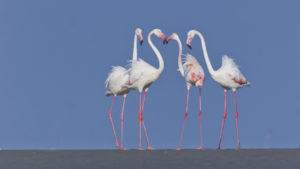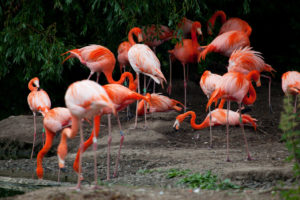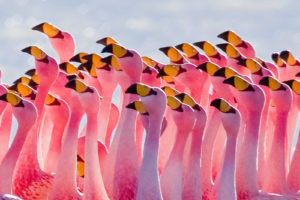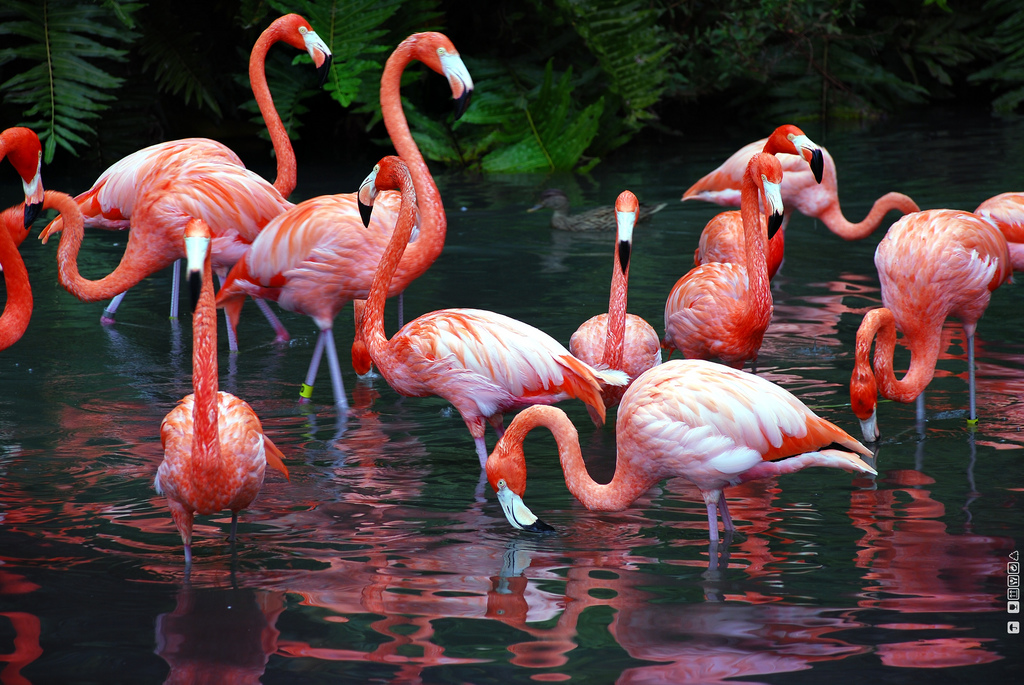Flamingos are a type of wading bird that lives in areas such as shallow lakes, lagoons, mangrove swamps, tidal flats and sandy islands. They’re famous for their bright pink feathers, stilt like legs and their “S” shapes neck. Take a look below for 27 more interesting and fun facts about flamingos.
1. There are 6 different species of flamingo. They are the greater flamingo, lesser flamingo, Chilean flamingo, Andean flamingo, James’ flamingo, or puna flamingo, and the American, or Caribbean, flamingo.
2. They’re known for living between 20 and 30 years in the wild. In captivity, some are known to live up to 40 years due to a lack of predators.
3. Chilean flamingos are found in temperate South American areas. The Andean flamingo and James’ flamingo is found in the high Andes mountains in Peru, Chile, Bolivia and Argentina. The American flamingo is found in the West Indies, Yucatan, and the Galapagos Islands.
4. The greater flamingo is the most widespread species. They’re found in areas of Africa, Southern Europe, South Asia, and Southwest Asia. The lesser flamingo is the most numerous species. They can be found in the Great Rift Valley of Africa through to Northwest India.
5. Male flamingos are larger than female flamingos. They weigh more and have longer wingspans, however, it’s very difficult to tell by looking at them.
6. The largest species is the greater flamingo. They average between 120 and 145 centimeters, or 3.9 to 4.7 feet, in height. They average between 2.1 and 4.1 kilograms, or 4.6 and 9 pounds, in weight.

7. The average flamingo has a wingspan between 1 and 1.6 meters, or 3.3 and 5 feet.
8. The smallest species is the lesser flamingo. It average 80 to 90 centimeters, or 2.6 and 2.9 feet, in height. It weighs between 1.5 and 2 kilograms, or 3.3 and 4.4 pounds.
9. Flamingos are known as social birds. They live in relatively large groups that can sometimes number from the thousands to tens of thousands.
10. In East Africa, there’s a group of 1.5 million flamingos that coexist. This is the largest known flock in the world.
11. They communicate in a range of visual displays and vocalizations. They use these display to try and warn others members of the group about potential dangers.
12. When they’re taking off, flamingos will run several steps, begin flapping its wings, and then lift off into the air. When they’re landing, the procedure is reversed; they will touch down and then run several steps.
13. Flamingos fly with their head and neck stretched out in front and its legs trailing behind them. The flight speed of a flock of flamingos can reach between 50 and 60 kilometers per hour, or 31 and 37 miles per hour.
14. They’re known to fly between 500 and 600 kilometers, or 311 and 373 miles, each night between habitats.
15. The majority of their habitats have extremely high salt concentrations. Their only source of freshwater comes from boiling geysers. This is why flamingos are capable of drinking water that’s approaching boiling temperatures.

16. Flamingos excrete salt through their salt glands in their nostrils.
17. A flamingo’s pink feathers, legs and facial coloration comes from a diet that’s high in alpha and beta carotenoid pigments, including canthaxanthin. The richest known sources of carotenoids are from algae and various invertebrates that make up the entirety of a flamingo’s diet.
18. Researchers aren’t entirely sure why flamingos stand on one leg. Some theories suggest that there’s less heat lost through the leg if its tucked next to their body; however, this behaviour is noted even in hot climates. Other theories suggest that it’s just a comfortable position for the flamingo while standing.
19. Flamingos create very strong bonds, some are even known to be monogamous.
20. They will nest once a year, but flamingo colonies are known to breed at any time of the year.
21. Their nests are created from mud and will be between 30 to 60 centimeters, or 12 to 24 inches, high. On top of the nest, a female flamingo will lay one egg in a shallow hole. Both male and female flamingos will take turns incubating the egg.
22. The egg will hatch after about 30 days. When the flamingo offspring hatches, they will have white plumage.

23. When they hatch, the flamingo chick will stay in the nest for 5 to 12 days. During this time, the chick is fed crop milk that comes from the parents’ upper digest tract. Both male and female flamingos can feed the chick this way. Even flamingos that aren’t the chicks parents are able to act as foster feeders.
24. Flamingo chicks will grow their flight feathers after 11 weeks. During this time, their bill will begin to hook, allowing them to begin to feed itself.
25. Chicks lose their white color over a 2 to 3 year period, at which point their pink feathers will begin to show due to a change in diet.
26. While they have relatively few predators, their main predators are wild dogs, crocodiles, eagles and humans.
27. The word “flamingo” comes from the Spanish word “flamenco”, which comes from an earlier Latin word, “flamma”, which means flame or fire.




